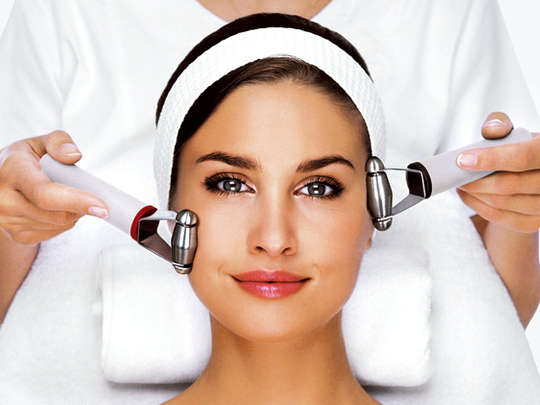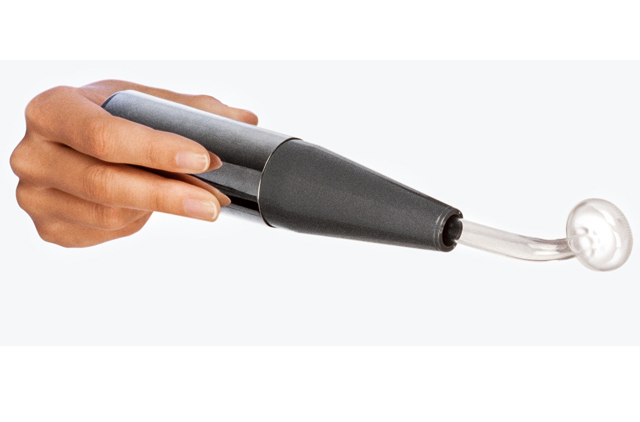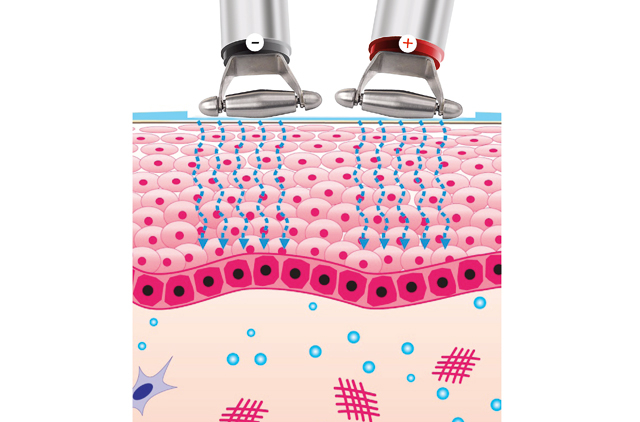
Ionisation isn't a fluffy beauty term. It is, as I was going to experience, one infused with almost every notable benefit available in the skincare industry. The kind of benefits you see not only in the mirror, but which work deep into layers of the skin barely touched by most facial formulations. The term is synonymous with Guinot (pronounced ghee-know), the 40-year-old French skincare brand that pioneered facials using microcurrents to deliver active ingredients to the skin. By ‘active' they mean ingredients in high concentration. The technique, developed into a skincare treatment called Hydradermie, is recognised worldwide as one of the brand's star offerings. Initially it was based on single ionisation that used positive microcurrents. Last month Guinot introduced the UAE to a double ionisation facial that uses both positive and negative microcurrents.
Before going any further, let me attempt to explain the term ‘ionisation'. It is a mild form of electrotherapy also referred to as ‘galvanic'. Back to the treatments. The improvement in both formulation of active ingredients and technology guarantees immediate results and exceptional effectiveness, not to mention comfort. How do I know? I tried both single and double ionisation.
Single ionisation
A skincare treatment involving microcurrents is hardly tempting. At Pastels, a Guinot-affiliated salon in the UAE, beauty therapist Isabella Desbonnets ticked off question by question… "What is your skin type?" "Any allergies?" "Any adverse reaction to Vitamin A?"…
After the initial analysis, I was ushered into the treatment room. I glanced at the galvanic equipment - two shiny electrodes of negative and positive charge and a glass-tipped one of high frequency - flanked by a collection of Guinot gels and serums.
"Am I going to feel any pain?" I asked.
"Oh no!" said Desbonnets. "It's really relaxing. You might feel a slightly heightened sensation as the electrode roller glides over your skin."
Reassured, I asked her if there were any unpleasant parts to the treatment. She replied, "Well, you may experience a distinct metallic taste when the electrode glides around your mouth. It's temporary. Your skin will look beautifully refreshed."
The consultation revealed dehydrated skin around my mouth and temples, and minor pigmentation. "You need hydration and special treatment for pigmentation," Desbonnets said, explaining that the treatment would be customised for my skin. "After I cleanse and exfoliate your skin [15 mins], I will apply active skin ingredients followed by the low frequency of positive microcurrents [single ionisation procedure], which will push ingredients at a cellular level."
When it was time to use the electrodes, Desbonnets handed me a metal electrode wrapped in a moist towel. "This is the ionisation part that will last for about five minutes. You have to hold the negative electrode so I can use the positive one on your face," she said.
Anticipating the worst, I stiffened. "Relax," she said, "It's like getting a massage." As the roller moved closer to my jawline, I tasted that metallic tang she had mentioned, though it passed in a couple of minutes. Next was the high-frequency glass-tipped electrode to oxygenate the skin. "It will also create an antibacterial effect," said Desbonnets, placing gauze on my face and using the oxygenating electrode with gentle, circular movements.
Next a gel (again tailored for my skin) was applied and massaged in for about 15 minutes, followed by a non-drying customised mask (another 15 minutes). My treatment ended with a hydrating serum.
Afterwards my face looked dewy and supple. Desbonnets said it would stay that way for a week. It did.
Double ionisation
The only way to find out how effective the new Hydradermie Double Ionisation was, was to try it. Two weeks later, the recommended gap between treatments, I visited the Guinot training centre in Dubai at Nazih Trading, the exclusive GCC distributor for the brand.
I learnt that the new treatment uses both positive and negative microcurrents or ions to deliver active ingredients. The gels were reformulated to work with the negative and positive charged ions. The Hydradermie double ionisation system also has advanced electrode rollers with specialised, contoured side balls to treat38 per cent more surface area, especially difficult-to-treat areas like the chin, eyes, mouth and laughter lines. In other words, increased precision. The evidence emerged an hour after I left the treatment room.
The main difference was in the level of comfort. The Hydradermie Double Ionisation does away with two of its predecessor's disadvantages - the inconvenience of holding the handle of a negative electrode and the resulting unpleasant taste. The electrodes - positive and negative - were used one at a time. There were several similarities in the treatment stages - the gentle massage movement and the choice of treatment gels according to my skin's condition. The verdict? My skin felt plumped-up and looked radiant. The Hydradermie double ionisation was twice as effective.
The science behind the product
So what is Guinot's secret? Sandrine Carliez, an international training and development representative from Guinot, Paris, spoke to me during the launch visit. "The ionisation machine has been around for decades. Hydradermie care is well known around the world; we have more than 1,700 salons in France itself," she said.
"What would you attribute its success to?" I asked.
"In the Hydradermie Double ionisation, the low frequency microcurrent stimulates the muscle level in the skin, toning it. The combination of positive and negative ions and the improved gels combined with gentle massage provide deeper and faster penetration of the plant-based active ingredients. We have several kinds of gels to target dryness, sensitivity, wrinkles and pigmentation, among other conditions. A combination of these gels achieves beauty goals like radiance, smoothed features, purified pores, hydration and so on.
"The gels have a common base of sodium lactate -a superior moisturiser, which works with the positive and negative ions for hydrated, baby skin. Further, the skin reacts to the microcurrent by producing sebum, resulting in plumped-up skin. We also have several other Guinot patented complexes, which when used in contact with the positive and negative ions, cleanse and regenerate the skin at a cellular level."
"What about the high-frequency electrode? What does that do?" I asked.
"The term ‘oxygenate' in the treatment refers to the high-frequency phase. High-frequency current is used to oxygenate the skin by stimulating the blood network below the surface of the skin, increasing the circulation, and bringing new nutrients and oxygen to the skin cells. It also has an antibacterial effect. The treatment is finished with a customised mask and relaxing massage to boost the skin, leaving it glowing."
"Are there any risks?" I asked. Carliez replied, "Our beauty therapists take mandatory training courses before using the equipment and follow specific protocol. The consultation is also thorough to determine the right treatment and address contraindications."
On a parting note, I asked how frequently one should get a Hydradermie treatment done. "As often as your skin needs it," she said.
I can't wait for my next appointment.














